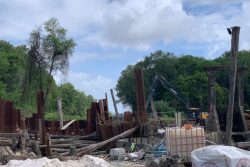Dear Editor,
After reading your news article, ‘Ramotar sees closure of Amaila deal in months,’ (January 1), sourced from his New Year’s Message, I could not help harking back to an article in The Economist of May 14, 2013, ‘Hydropower in Guyana: Shrouded in secrecy.’
It noted that “plans to build Amaila date from 1997, though Sithe (Global) only got involved in 2009. The estimated cost has risen steadily. An access road is unfinished. There is as yet no economic feasibility study for the project; when completed, the study will remain confidential, as is GPL’s outline power-purchase agreement. Opposition parties complain that the government is being secretive about Amaila. On April 24 (2013), they blocked funds for a government equity-stake in the project.”
But here is the kicker in the article: “If the Amaila is as beneficial as its backers claim, an open debate might generate broader support for the project, and cut its US$56m bill for political risk assurance.”
Editor, we can readily agree that Guyana needs to reduce its approximately US$350M annual import fuel bill and that 750,000 Guyanese – private and business consumers – deserve a more reliable supply of electricity after almost four decades. So, if this Amaila project is supposed to benefit Guyanese, why is there so much secrecy about its details?
Even in the ensuing months after Sithe Global announced its pull-out from the Amaila deal in 2013, Guyanese still don’t have answers to lots of questions about the project, especially how its estimates rose from an original US$450M to around US$900M without a single brick being laid for the generating facility or who will be running the facility after construction is completed.
In fact, some have asked if the Amaila Hydro access road project could balloon from US$15M when the contract was signed March 26, 2010 in President Bharrat Jagdeo’s office to US$41M in 2014, what is there to stop construction costs of the Amaila generating facility from ballooning from an estimated US$900M to US$2B by the time it is finished.
With Sithe Global out of the picture and the Chinese, from whom Mr Jagdeo secured a US$500M loan towards the project, being the single biggest investor, the next obvious question is whether the PPP regime would collaborate with the Chinese to force the project on Guyanese. If the Chinese will be funding, building, owning and operating the Amaila as part of the BOOT component of the deal, it will likely mean the nation’s entire electricity supply would be in the hands of the Chinese, because the Chinese-owned Bosai bauxite mining company in Linden, already supplies Region 10 with electricity. How can this not be a national security concern to private and business consumers, especially given that the nation does not know what is contained in the deals that have been or will be struck with the Chinese?
In a separate article in The Economist, ‘The Queensway syndicate and the Africa trade,’ (August 13, 2011), it reported that “China’s oil trade with Africa is dominated by an opaque syndicate [in which] ordinary Africans appear to do badly out of its hugely lucrative deals.” Reference was made to a syndicate that calls itself China International Fund or China Sonangol. “Over the past seven years,” reports The Economist, “it has signed contracts worth billions of dollars for oil, minerals and diamonds from Africa. These deals are shrouded in secrecy. However, they appear to grant the Queensway syndicate remarkably profitable terms. If that is right, then they would be depriving some of the world’s poorest people of desperately needed wealth. Because the syndicate has done deals with the regimes in strife-torn places, such as Zimbabwe and Guinea, it may also have indirectly helped sustain violent conflicts.”
In Guyana, where partisan political strife has been ramped up since November 2011 and reached saturation point last November with the prorogation of Parliament, deals struck in secret between the PPP regime and the Chinese can have long-term repercussions if not revisited.
I am well aware that, as part of his energy agenda, President Ramotar was anxious about oil being found during his presidency, so if this revival of the Amaila project is his fall-back plan since oil was not found, he needs to come ‘straight and full’ with the people of Guyana about the details of the Amaila project and not advertently add to the woes of Guyana’s oil import fuel bill and GPL’s electricity supply problems. Let there be a genuine public debate!
If, on the other hand, he and the PPP intend to use the revival of Amaila as a political football or electioneering gimmick by placing it on the 2015 ballot to merely win back a parliamentary majority, he should be told right now that Guyanese will vote no, because the current version of Amaila is a Jagdeo brainchild that benefits a select few at the expense of ordinary Guyanese.
In fact, since Mr Jagdeo, who enjoys free electricity at taxpayers’ expense, was the single reason why the PPP lost its parliamentary majority in November 2011, and since he continues to feature prominently as a puppet master in the Donald Ramotar administration, then a vote to give back the PPP its majority would be akin to repeatedly trying the same thing over and over and expecting to get a different result. It is indeed sad that after three years, the Ramotar presidency has replaced hope with hype!
Yours faithfully,
Emile Mervin




